Save More Cash When Getting Rid of Bulky Waste at Home
Disposing of large, unwanted items can be an overwhelming--and often expensive--task. Whether you're preparing for a move, remodeling, or simply decluttering, bulky waste removal can eat into your budget if not handled wisely. However, with a bit of planning and some savvy strategies, you can save more cash while getting rid of bulky waste at home. This comprehensive guide will show you exactly how to cut costs, make eco-friendly choices, and keep your living space tidy with minimal financial stress.
Understanding Bulky Waste and Its Challenges
Bulky waste refers to large household items that are too big to be collected by regular trash services. This category includes furniture, mattresses, appliances, carpets, and garden refuse. Because of their size and weight, these items can pose logistical and financial challenges for homeowners, renters, and landlords alike.
- Limited curbside pick-up options
- Extra fees for landfill or transfer stations
- Lack of transport or manpower to move items
- Potential environmental impact
With these hurdles in mind, let's explore the most effective ways to save money on bulky waste clearance at home.

1. Organize and Plan Your Bulky Waste Removal
Preparation is key to keeping costs low. Rather than disposing of items one at a time, collect all your unwanted bulky goods and plan their removal in one go. Here's how you can efficiently organize bulky rubbish disposal:
- List your items: Create a full inventory of what you want to remove--for example, an old sofa, broken washing machine, or garden debris.
- Assess condition: Some items can be reused, sold, or donated, which can offset removal costs or even make you money.
- Set a deadline: Give yourself a time frame to get everything out. This way you can book services or trips efficiently.
Tip: If possible, schedule waste removal outside peak seasons, like spring or early summer, when fees and demand might be higher.
2. Explore Free or Low-Cost Bulky Waste Collection Services
Many municipalities offer bulky waste pick-up services--sometimes for free or at a significant discount. The key is knowing what's available in your area and understanding how to make the most of these programs.
Check with Your Local Council
Most local councils provide scheduled or on-demand large item collection services. These might include free annual pick-ups or discounted rates for certain items.
- Visit your local authority's website for guidelines, schedules, and booking forms.
- Be aware of limitations--some councils restrict the number of items or collections per year.
- Follow the rules for curbside placement, packaging, and accepted materials.
Community Clean-Up Events
Some towns and cities organize annual clean-up days where residents can dispose of bulk waste for free or at reduced rates. Keep an eye on local bulletins for announcements.
Charity Collections and Reuse Schemes
Numerous charitable organizations will collect reusable furniture and appliances at no cost. This not only saves money, but supports community projects and prevents landfill waste.
- Contact local charities to see what items they accept.
- Ensure items are clean and in reasonable condition.
- Some organizations may even issue donation receipts for tax deductions.
3. Rent a Vehicle and Do It Yourself
Hiring a man-with-a-van service or paying for commercial haulers can add up, especially for larger jobs. If you or a friend have access to a large car or van, consider a DIY bulky waste disposal run.
- Borrow or rent a vehicle for a short term--often cheaper than haulage companies.
- Team up with neighbors for a group trip and split the costs.
- Check your local recycling center's fees; some accept certain bulk items free of charge.
Safety and Preparation Tips
When carrying out your own bulky waste disposal:
- Disassemble large furniture to fit more in your vehicle.
- Lift items carefully to prevent injuries.
- Secure loads properly with straps.
4. Sell or Donate Usable Items
Before paying to dispose of bulky household items, investigate whether you can sell, donate, or give them away. Not only does this save you money on disposal fees, but it can also bring in some extra cash.
Ways to Sell or Rehome Bulky Goods
- Online marketplaces: List furniture and appliances on platforms like Facebook Marketplace, Gumtree, Craigslist, or eBay.
- Garage sales: Combine your clear-out with a yard sale for neighbors and passersby.
- Upcycle or repair: With a bit of effort, broken items may be fixed up and sold for profit.
Donation Options
- Contact local shelters or community centers.
- Offer items to friends, family, or neighbors who might need them.
- Look for "freecycle" groups or community social media pages.
Remember, the less bulky waste you need to dispose of, the more money you'll save!
5. Break Down Items to Reduce Volume and Disposal Costs
Some waste disposal services and dump sites charge based on the space your items take up. By dismantling and compacting bulky waste, you'll save money and get more efficient disposal.
How to Break Down Bulky Waste at Home
- Remove legs, arms, and cushions from sofas and chairs.
- Disassemble beds and wardrobes--keep hardware in a bag if you need to reassemble or donate.
- Smash up broken furniture safely, and separate recyclables such as metal, wood, and fabric.
- Cut up carpet rolls, and tie branches in tidy bundles for garden waste collection.
Always use protective gear, like gloves and goggles, when dismantling items. Avoid damaging reusable or sellable parts in the process.
6. Compare Local Removal and Disposal Services
If a professional bulky waste removal service is necessary, don't just accept the first quote you receive. Comparison shopping can help you save significantly on removal fees.
- Request multiple quotes from at least three providers.
- Look for companies with transparent, upfront pricing and no hidden surcharges.
- Check for discounts on off-peak days or for multiple items.
- Read reviews and check licenses or insurance.
Tip:
Grouping several items together for collection usually works out cheaper per item than booking multiple, separate pick-ups.
7. Recycle Where Possible
Recycling isn't just an eco-friendly choice--it can also help you cut down on bulky waste disposal costs. Many recycling centers accept specific types of bulk items for free or at a reduced cost.
- Electrical appliances: Take old fridges, washing machines, and TVs to dedicated e-waste recycling points.
- Metals and scrap: Metal bedframes, pipes, or shelving can be taken to metal recyclers--and you might even be paid by weight!
- Wood and green waste: Some tips or transfer stations process wood, branches, and leaves at a lower fee.
- Cardboard and plastics: These materials can often go in your regular recycling bins if broken down small enough.
8. Check Appliance Retailer and Manufacturer Takeback Programs
If disposing of large electrical or fitness equipment, always ask retailers if they offer takeback schemes when delivering new items. Large chain stores frequently collect your old items for free or at minimal cost when you buy replacements.
- Appliance shops may collect cookers, fridges, washers, and TVs.
- Some mattress retailers offer removal of old beds with home delivery of new ones.
- Look for retailer promotions including free haul-away service.
9. Avoid Fines by Following Local Regulations
Illegal dumping or improper disposal of bulky waste can result in hefty fines, completely negating any savings on the removal itself.
- Follow all municipal guidelines for placement, sorting, and timing of bulk waste.
- Don't leave items on the curb outside permitted days.
- Avoid fly-tipping at unauthorized dump sites.
When in doubt, contact your local council for guidance--staying compliant keeps your costs predictable.
10. Get Creative to Save Even More Money
Sometimes thinking outside the box is the best way to save on bulky waste removal at home.
- Swap meets: Organize a neighborhood swap for furniture and large goods.
- Community social media: Post "curb alert" notices when offering items for free pickup.
- Upcycling projects: Convert old furniture into shelving, planters, or workbenches rather than tossing it.

Summary: Save More, Waste Less
Disposing of bulky household items doesn't have to break the bank. By using these strategies--organizing your clear-out, taking advantage of free services, selling or donating where possible, dismantling items, and comparing local removal options--you can save more cash when getting rid of bulky waste at home.
Always consider the most sustainable options, and check for ways to recoup costs through sales, tax-deductible donations, or recycling rebates. With smart planning, you'll clear your home, help the environment, and keep your wallet in great shape!
Frequently Asked Questions (FAQ)
- What counts as bulky waste? - Typically, large items such as sofas, white goods, mattresses, garden branches, and similar items too large for regular refuse collection.
- Can I put bulky items in my regular bin? - No, most home refuse bins are not designed for oversized waste. Special arrangements are needed.
- How can I avoid bulky waste disposal fees entirely? - Sell, give away, or arrange charity collection for reusable items, and use free council pickups when available.
- Is it safe to break down bulky items myself? - Yes, if you use the proper tools and safety equipment. When in doubt, consult a professional.
For even more ways to save on bulky waste removal, contact your local council or visit their website for detailed disposal and recycling options relevant to your area.
